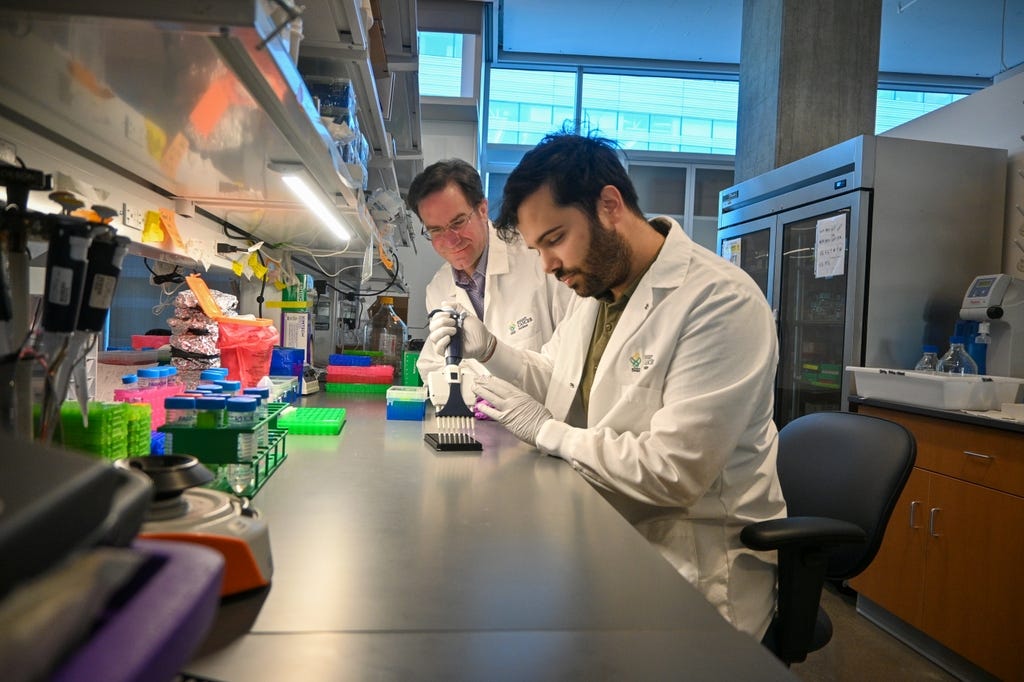Sci-Ed Update 341
B12 & brain function, new discovery about hearing, things we forget about cells, STEM teaching report, milk & cheese benefit microbiome, is empathy biased, pancreatic cancer blood test, biological sex
Biological sex is not as simple as male or female
Sex is messy.
It’s not just about chromosomes. Or reproductive cells. Or any other binary metric. Many genetic, environmental and developmental variations can produce what are thought of as masculine and feminine traits in the same person. And so sex, scientists say, should be viewed in all its complex glory.
“Sex is a multifaceted trait that has some components that are present at birth and some components that developed during puberty, and each of these components shows variation,” says Sam Sharpe, an evolutionary biologist at Kansas State University in Manhattan.
Yet a definition of biological sex put forth by U.S. President Donald Trump designates people as either male or female based solely on the size of the reproductive cells they make.
Millions of Americans don’t fit that narrow definition through no fault of their own — and many don’t even know it.
Read more→ AandP.info/fe4621
Is Your Empathy Biased?
Is empathy a helpful tool for understanding other people better, or does it simply reflect our biases?
This question has plagued researchers and philosophers for decades. Some have argued that empathy is flawed and problematic (especially in certain situations, like judging people in a court of law or choosing where to donate money). After all, we resonate more naturally with the feelings of people who are similar to us, making empathy dependent on our own experiences and backgrounds.
But philosopher Heidi Maibom believes the opposite is true—that taking other people’s perspectives leads to greater social understanding and justice.
Read more→ AandP.info/ac8691
Consensus Study Highlights | January 2025
Transforming Undergraduate STEM Education: Supporting Equitable and Effective Teaching
High quality instruction, learning, and engagement in STEM should be a key priority for colleges and universities across the United States—but only a relatively small number of students currently benefit from the use of evidence-based methods for teaching STEM subjects.
As concerns about tuition costs increase and the need to reinforce the STEM workforce grows, institution leaders, academic units, instructors, and other stakeholders have important roles in improving the landscape of undergraduate STEM education so that all students can thrive. This challenge does not present a one-time goal that can be checked off, it is a long-term journey of continuous improvement.
As a step toward addressing inequities in undergraduate STEM education, the report presents a set of principles that draw on decades of research and articulate key aspects of pedagogy critical to the student-centered approach to learning necessary to achieve equitable and effective learning experiences.
Read more→ AandP.info/c84e03
New blood test identifies hard-to-detect pancreatic cancer with 85% accuracy

A new blood test could help doctors detect pancreatic cancer earlier, potentially improving survival rates for one of the deadliest cancers.
Researchers at Oregon Health & Science University have developed a test called PAC-MANN, the abbreviation for “protease activity-based assay using a magnetic nanosensor,” which uses a small blood sample to detect changes in protease activity — a key indicator of pancreatic ductal adenocarcinoma, or PDAC, the most common and deadly form of pancreatic cancer.
Pancreatic cancer is often diagnosed at an advanced stage, when treatment options are limited. Current tests, such as carbohydrate antigen 19-9, or CA 19-9, are good at indicating prognosis, but aren’t sensitive enough for early-stage detection. The new PAC-MANN test fills this gap by identifying signs of cancer-related activity in the blood, helping catch cancers earlier.
Read more→ AandP.info/211d00
Milk boosts gut-friendly bacteria while cheese alters microbiome balance, study reveals
In a recent study published in the journal Nutrients, researchers in the United States explored the influence of dairy consumption on colonic mucosa-associated gut microbiota. By investigating specific bacterial composition changes linked to dairy intake, they highlighted its implications for individual and public health.
Higher consumption of total dairy and milk was associated with increased microbial alpha-diversity, indicating greater bacterial richness and evenness. In contrast, higher cheese consumption was linked to lower microbial diversity. Beta-diversity analysis revealed significant differences in gut bacterial composition based on dairy intake levels.
Participants who consumed more dairy and milk exhibited a higher relative abundance of Faecalibacterium, a bacterium known for its anti-inflammatory properties. Increased milk intake was also associated with greater levels of Akkermansia, a mucin-degrading bacterium linked to improved gut barrier function and metabolic health. However, the association between Akkermansia and milk intake was attenuated after adjusting for lactose intake, suggesting that lactose or other dairy components may act as prebiotics.
Conversely, higher cheese consumption correlated with a lower relative abundance of Bacteroides and Subdoligranulum. While Bacteroides have been implicated in colorectal cancer (CRC), lower levels of Subdoligranulum have been linked to metabolic disorders. Additionally, the study found that higher total dairy intake was negatively associated with Bacteroides, suggesting a complex relationship between dairy components and microbial composition. The varying impact of milk and cheese on gut microbiota composition may be due to differences in their nutrient content and fermentation process. Milk, which contains more lactose, may promote the growth of beneficial bacteria, while cheese, which undergoes fermentation, may have distinct effects on gut microbial communities.
Read more→ AandP.info/e389eb
Scientists Just Found a Hidden Set of 'Modes' in The Human Ear

In an effort to better understand how the inner ear can hear the quietest of noises, researchers from Yale University stumbled across a potential new way the human body actively manages sound waves that may help us sift out extremely low frequencies.
"We set out to understand how the ear can tune itself to detect faint sounds without becoming unstable and responding even in the absence of external sounds," says physicist Benjamin Machta.
"But in getting to the bottom of this we stumbled onto a new set of low frequency mechanical modes that the cochlea likely supports."
Machta and his team's mathematical modeling of the snail-like auditory sensing organ known as the cochlea reveals a new layer of complexity in how our hearing actively manages sound waves to find meaning in all that noise.
To become sounds we can hear, vibrations push and pull frequency-specific patches of tiny hairs in the cochlea's membrane, forcing them to emit nervous signals that are transmitted to the brain.
Those vibrations can easily lose steam as they ripple along the membrane's surface, dulling tones and decreasing volume. It's been understood for some time discrete patches of the cochlea's hairs can amplify surface vibrations with a precise, well-timed 'kick' to assist in our hearing of the tones those patches are most sensitive to detecting.
Now it seems the ear has a similar reflex that broadly tunes surface waves regardless of its tone, sensitively striking a balance that cancels unwanted noise without introducing phantom sounds.
The super-sensitive hairs that line the basilar membrane in the cochlea can work in both a localized way, and a more extended, collective way, the models suggested, adapting as needed to manage sound waves as they're converted into electrical signals.
Read more→ AandP.info/48173b
Rare genetic disorder treated in womb for the first time
A two-and-a-half-year-old girl shows no signs of a rare genetic disorder, after becoming the first person to be treated for the motor-neuron condition while in the womb. The child’s mother took the gene-targeting drug during late pregnancy, and the child continues to take it.
The “baby has been effectively treated, with no manifestations of the condition”, says Michelle Farrar, a paediatric neurologist at University of New South Wales in Sydney, Australia. The results were published in the New England Journal of Medicine yesterday.
Read more→ AandP.info/83e46e
Ten Things We Forget to Tell Students About Cells | A Forest in My Office
We list ten things that we often forget to tell—or remind—our students about cells. We learn how to create a peaceful forest-like retreat in our office using soundscapes, I get my winter shorts ready (seriously), and Margaret Reece comments about teaching urinary concepts. That last topic spurs a rant from Kevin on diversity of course sections.
00:00 | Introduction
00:56 | Pee Again
07:46 | A Forest in My Office
13:54 | Sponsored by AAA
14:27 | Getting Out My Winter Shorts
17:31 | Sponsored by HAPI
18:02 | Things We Forget to Tell Students About Cells
33:45 | Sponsored by HAPS
34:20 | More Things We Forget to Tell Students About Cells
50:02 | Staying Connected
To listen to this episode, click on the play button above ⏵ (if present) or this link→ theAPprofessor.org/podcast-episode-126.html
Low-Normal B12 Levels Linked to Slower Brain Processing
Even when within the normal range, lower levels of vitamin B12 may contribute to cognitive decline, according to a new study. Researchers found that older adults with lower biologically active B12 had slower cognitive processing and more white matter lesions, despite meeting current nutritional requirements.
These findings suggest that the definition of B12 deficiency may need revision to incorporate functional biomarkers rather than relying on fixed thresholds. Researchers recommend further study and potential supplementation for older adults to prevent cognitive impairment.
Key Facts
Subtle Cognitive Decline: Older adults with lower active B12 levels performed worse on cognitive tests measuring processing speed and reaction times.
Brain Lesions: MRI scans revealed increased white matter lesions in participants with lower B12, which may contribute to dementia and stroke risk.
Revisiting B12 Guidelines: Researchers suggest current B12 recommendations may be insufficient for preventing neurological decline and warrant reassessment.
Read more→ AandP.info/40b811








